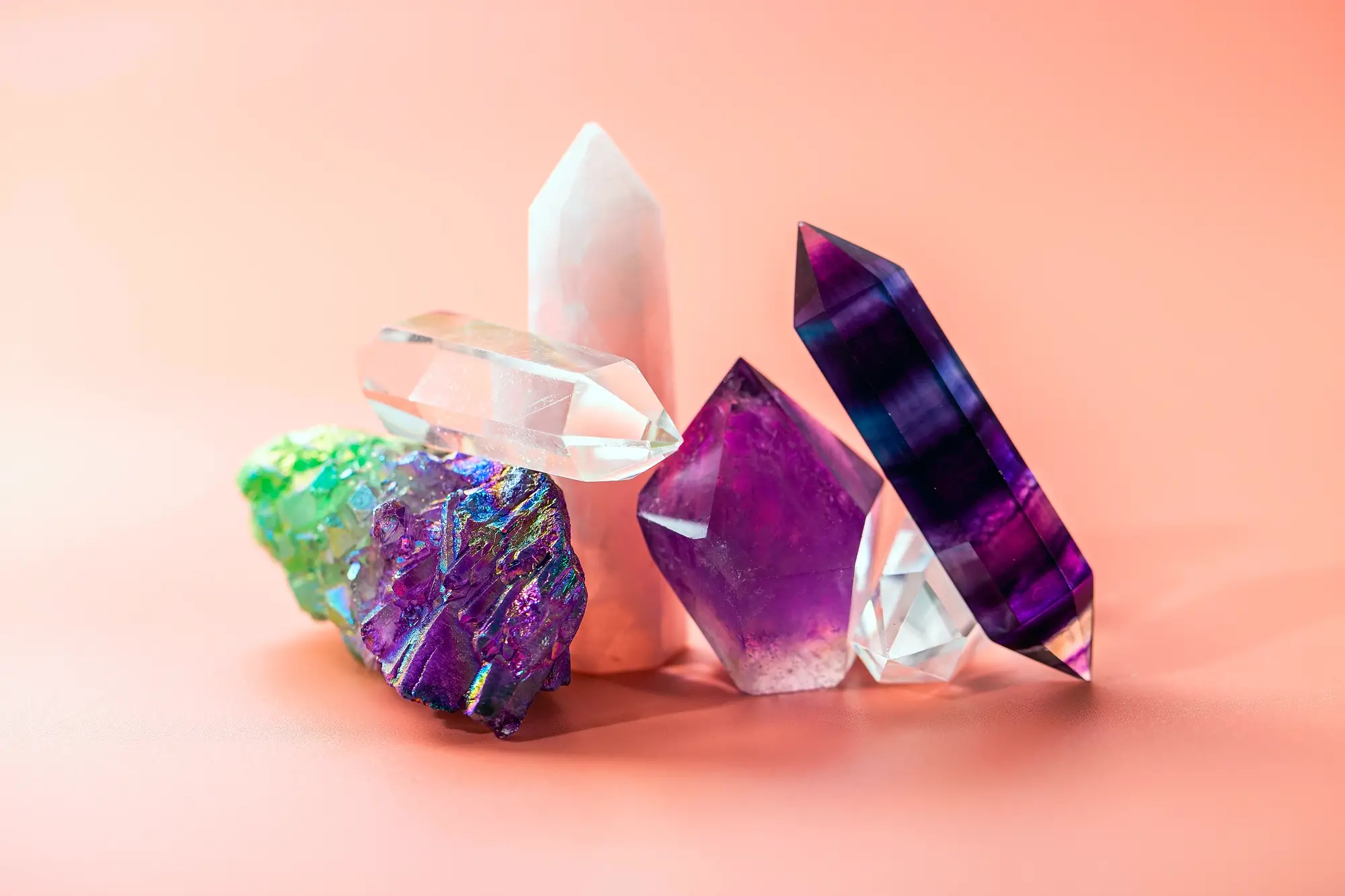7 Steps to Start a Crystal Business (1st $1,000 in Sales)

The interest in crystals has grown immensely in recent years. Thus, there’s a large opportunity in the market for someone to start a crystal business and leverage this growing demand.
The main key to success and profitability in this industry will be finding the right suppliers and attracting customers. So in this step-by-step guide, we’ll explain everything you need to know about starting a crystal business.
- Identify a Niche Audience
- Find a Niche Product
- Define Sales Channels
- Identify the Minimum Budget
- Form a Legal Entity
- Set Up the Shop
- Reach First $1,000 in Sales
How to Start a Crystal Business?
1. Identify a Niche Audience
To start selling crystals for a living, you need to identify your niche audience or the specific group or demographic whom you will sell your crystals.
If you cast a wide net and try to sell to everyone, you may end up selling to no one. When customers sense that you’re speaking to a general audience, they may not feel like you understand their specific needs and desires.
The more you dial in your niche and identify a specific ideal customer base, the better you can tailor your products and offerings to your audience. This will make them feel connected to your crystal business and improve their customer loyalty.
Here are some examples of niche audiences:
- Business idea: Bath bomb online store.
- Potential niche audience: Millenial women who use organic cosmetics and products as a means of relaxation and are Instagram influencers.
- Potential market gap: None of the current products targets fashionistas specifically.
- Business idea: Dog treats online store.
- Potential niche audience: Health-conscious small dog owners.
Potential problem: Toxic ingredients, small dogs are often picky eaters and don’t like the small variety of flavors.
1.1 Analyze Crystal Niche Communities
To discover your niche audience, you should first explore a handful of niche communities online to learn more about them and what they want from a crystal shop. Oftentimes, you can discover these types of communities on Reddit, Quora, forums, or social media platforms like Facebook, Instagram, TikTok, and Twitter.
From there, you will get a realistic sense of the common problems, ideas, and concerns they have about the industry. Doing this research will give you a better idea of who your audience is and help you stay up-to-date on the latest trends and concerns within the industry.
Here are some examples of crystal niche communities:
- https://www.reddit.com/r/Crystals/
- https://www.reddit.com/r/crystalhealing/
- https://www.reddit.com/r/CrystalBazaar/
- https://www.spiritualforums.com/vb/forumdisplay.php?f=101
- https://www.mentalhealthforum.net/forum/threads/crystal-healing.101698/
- https://www.facebook.com/groups/868172513329129/
- https://www.facebook.com/groups/1001484960056060/
- https://www.facebook.com/groups/264371595089043/
1.2 Find a Problem or a Market Gap
When you visit these communities online, you want to find problems or market gaps in the industry that you can address with your own crystals business.
To discover potential market gaps, ask yourself the following questions:
- Who uses crystals? Why?
- What problem is the product solving? Are there many problems?
- What do existing crystals shops do correctly? What could they do better?
Above all, you should look out for common concerns that the community lays out, or frequent areas of frustration.
For example, many in the community are looking for crystals that are ethically sourced. Plus, there is a need for education of crystals alongside the products for new crystal users since the space is growing quickly.
1.3 Formulate the Niche Audience
Once you’ve examined these niche communities online and identified some of the frequent concerns or gaps in the market, you can begin to formulate your niche audience.
Determine who your ideal customers are, and identify their needs and what problems they’re trying to solve with crystals.
For instance, you may narrow your focus on new crystal users who are novices in the field and interested in exploring the craft further. As we’ve discussed, the way you connect with them will be different than how you would present your business to experienced users.
Go as specific as possible with this step, as this will help guide your crystal’s small business and how you operate.
Here are some examples of niche audiences:
- Health-conscious Chihuahua owners
- Instagram fashionistas who love aromatherapy as a way of relaxation
- Single parent local gym owners
Related: How to Start a Sock Business?
2. Find a Niche Product
Now that you know the niche audience you’re selling to, you need to identify the niche products that will be the solution to their problem.
For instance, think back on the early days of the pandemic when companies in all industries began to produce face masks and hand sanitizer to meet the growing demand amid widespread shortages.
So in the case of novice crystal users, you may want to focus on the more widely-used crystals like rose quartz or amethyst that they can find a lot of information about. This audience may be turned away by lesser-known or obscure crystals that they don’t know how to use.
2.1 Analyze the Competitors
Next, you need to analyze the competition in the space. While it may seem like a problem to face a lot of competition, this is actually a good sign. It means that there’s money to be made in the industry.
Search for crystal shops that sell similar products to determine who your main competitors are. From there, you can observe how they market their products, the depth of their offerings, customer loyalty programs, and other strategies that they are utilizing to bring in sales.
All of this information can give you a good idea of how to approach your own crystal business and give you concrete examples of what works.
2.2 Unique Selling Proposition
To sell crystals profitably, you need to identify your unique selling proposition (USP). This is the unique factor that makes your crystals stand out and be different from every other seller.
Especially as the industry becomes more saturated, you need to provide potential customers with a clear reason why they should choose your crystals over others.
When coming up with your USP, focus on the specific benefits your crystals provide and how they are a solution to the problems they’re experiencing.
Here are some examples of USP from well-known brands:
- Domino’s: “Hot pizza in 30 minutes or less, guaranteed”
- Robinhood: “Investing for everyone”
- Canva: “Empowering the world to design”
- Warby Parker: “Try 5 frames at home for free”
- TOMS: “Shoes for moving forward”
2.3 Choose a Product
When you finally decide on the products you’ll sell, make sure they provide a clear solution to the problems and market gaps that you identified during the research process. For example, you may choose to sell quartz and amethyst as an entry point for novice users to get started with crystals.
Assess whether your niche audience will respond well to your selected product and how other competitors in the space are marketing similar products.
With these points in mind, you can have a clear path forward for how you’ll differentiate from the other sellers on the market and benefit your niche audience.
2.4 Find Suppliers
Figuring out where to source crystals to sell is an important step when you open a crystal shop. You need to source a good supplier from the beginning, as this will influence the quality of goods you provide and your profitability.
This step will require some research on your end so you can find the right supplier for the given products you want to sell. Do a quick Google search for “crystal wholesalers” or “crystal suppliers”, or make similar searches on Instagram, Facebook, or online marketplaces like eBay or Etsy to discover potential suppliers.
As you’re conducting research, make sure to focus on the reviews of their quality, sourcing, and authenticity of their crystals. Better yet, request small samples, so you examine the product for yourself.
To learn more about where to find a crystal dealer, visit the following sources:
- https://www.facebook.com/groups/1462035024087253
- https://www.facebook.com/groups/2790741087834522
- https://www.ebay.com/sch/i.html?_from=R40&_trksid=p2047675.m570.l1311&_nkw=wholesale+crystals&_sacat=0
- https://www.etsy.com/market/wholesale_crystals
- https://www.aliexpress.com/w/wholesale-crystals.html
3. Define Sales Channels
As you’re getting started with your crystals business, you need to think through how you will actually generate sales.
There are many sales channels available, but each situation is different depending on your niche audience, the products you’re selling, your brand identity, budget, resources, and more.
In the beginning, you may be able to promote your brand to those in your immediate circle, like friends and family or social media followers. However, it’s important to think about the bigger picture and consider how you’ll generate sales moving forward, given the resources available to you.
Some people selling crystals will have access to professionals with sales and marketing experience, or maybe they have this expertise themselves.
Here are some examples of potential sales channels:
- Your personal: Facebook friends, Instagram followers, colleagues, schoolmates
- Paid advertising: Google ads, Facebook ads, Tiktok ads, Twitter ads, Pinterest ads
- Marketplaces: Amazon, Etsy, Ebay
- Communities: Facebook groups, Reddit, Quora, forums
- Other: Blogging, Craigslist, promoting in the real world (e.g. schools, workplaces, malls)
4. Identify the Minimum Budget
There is a common misconception that you need a lot of money to open a crystal shop. But if that was the case, almost no one would be able to afford opening a crystals shop!
Instead, think of how much money you’ll need to reach your first $1,000 in sales. Once you start making money, banks will be more willing to lend you the money you need for ongoing operations with proof that the business works.
So, consider how much you plan on selling your products for and how many units you’d need to sell to hit $1,000 in sales. Then, you can determine how much you’ll need to spend on sourcing this number of units and any promotion. This will give you a good idea of how much money you’ll need to start off.
4.1 FFF and Personal Money
One way for crystal businesses to secure financing is through FFF or personal money. FFF stands for friends, family, and fools. This basically means someone you know will lend you the money to get started or continue operations.
This is a good option for someone in the early stages out who doesn’t have the proof of concept to request financing from a formal institution. Instead, they can make an arrangement with friends or family members with flexible terms to meet the needs of a growing business. Or, they can fund their venture for themselves with their own personal savings.
4.2 Bank Loans
Another option is to take out a bank loan. This method of financing is more formal and will require the business owner to have an in-depth business plan and meet the application requirements of the bank. Plus, the borrower will have structured repayment plans they must adhere to.
Getting a bank loan can be a good option for someone who has already been running their crystal business successfully for some time and can prove that it’s already self-sufficient.
To get money from a bank loan, you will need to qualify with a bank of your choice, apply, and get approved, then you’ll receive the funds directly to your bank account.
4.3 SBA Guaranteed Loans
The Small Business Administration (SBA) has a number of loan products to help small businesses get started and fund their operations.
When taking this route, the SBA substitutes the need for collateral and provides the lender with the guarantee that they’ll back the loan. So, if the borrower fails to repay the loan, the SBA will pay back the guaranteed portion.
You’ll need to find a lender that offers SBA loans, make sure your crystal business meets the proper requirements, apply, and receive the funds to your bank account upon approval.
The SBA only works with for-profit businesses in the United States, in addition to other requirements. So, crystal businesses looking to utilize this route should consider their qualifications beforehand.
4.4 Government Grants
In some cases, a crystal shop online may qualify for government grants. This is essentially free money that doesn’t need to be repaid, though the qualifications and types of grants available will vary from time to time.
You may find government grants at the local, state, or federal level for new businesses, so do your research to discover any potential grants you could qualify for and apply to as many as possible. After all–it’s free money!
If you’re approved, you may receive the funding directly to your bank account or in the form of a check.
4.5 Crowdfunding
Crowdfunding is when you receive a small amount of funding from a large number of public donors.
This method is best used for businesses that are just starting out, as it is not a formal financing route that typically requires an in-depth business plan or forecasts.
Small crystal businesses can set up a page on a crowdfunding site and make withdrawals as the page generates interest and investors.
Depending on the crowdfunding site, you may or may not need to pay back the funds you receive. So, make sure to keep this in mind when selecting which crowdfunding site to use.
5. Form a Legal Entity
Forming a legal entity is an important step you must take to sell crystals online. This is necessary to pay taxes, request funding, open a bank account, and other aspects of running a legitimate business.
There are a number of different legal entities you can choose from, including sole proprietor or LLC. Operating as an LLC comes with many benefits, as it can help minimize the personal risks and liability you face as a business owner.
Pay attention to the legal requirements of starting a business in your state, as you may need to apply for various business licenses or permits to operate legally. The last thing you want is to face legal consequences if you fail to register properly from the beginning.
5.1 Business Name
During this stage, you need to brainstorm crystal shop names for your business. Don’t overthink this step too much, though you can use the specific products you intend to sell to inspire crystal business names.
The important thing here is that the business name is available for registration and not protected under any patents or trademarks.
You can always change the name of your business later on, so don’t worry about changing your mind at some point.
Even still, consider names that are short, unique, and easy to remember, as this will help you with word-of-mouth marketing and referrals.
Plus, companies with names that are easy to spell and say tend to be more successful.
5.2 Choose a Business Structure
As we mentioned, there are a number of different options you can choose from for your business structure. Let’s take a deeper look at some of the main options:
- Sole proprietor: no legal distinction between the company and the owner, who is responsible for all debts and liabilities of the business but keeps all profits
- LLC: a mix between a corporation and sole proprietorships; the owners are not personally liable for the debts of the company
- S Corp: tax for any business that is an LLC or corporation; business income passed directly to shareholders
For those that sell crystals online, an LLC is the best choice since it limits the liability of the business owner, though is less complicated than a corporation.
5.3 Register for Taxes (EIN)
In order to pay taxes, your business must have an Employe Identification Number (EIN). You can easily file for an EIN with the IRS either online in minutes or by mail.
After receiving your EIN, you’ll need to select your tax year, which can either be the calendar year or a different 12-month fiscal year that you determine at this time. This will set your tax cycle and when you’ll need to pay your tax liabilities each year.
It’s important to note that if you’re a sole proprietor, you can use your social security number as your EIN.
5.4 Bank Account & Credit Card
It’s also important to get a business bank account and credit card opened as soon as you have your EIN. This will keep your business’ finances separate from your personal account, which will make it easier to track income and file your tax returns.
You can easily open a business bank account at most major banks, though you can shop around to find the most favorable rates and features. Once you have a preferred bank, you can bring your EIN, articles of incorporation, and other legal documents to open up the account.
From there, you can inquire with the bank about the additional steps to get a business credit card.
5.5 Insurance & Accounting
There are many types of business insurance to consider, though it can be a worthwhile investment as you start your crystal business. This can protect you from unexpected and harmful events.
Common insurance policies to consider include general liability, worker’s compensation if you have employees, professional liability, and a business owner’s policy, among others.
At the same time, you should consider hiring an accountant or bookkeeper or paying for bookkeeping software to keep your financial records organized and well documented throughout the year.
In either case, hiring a professional can be highly valuable and keep you from facing costly consequences.
5.6 Permits & Licenses
Lastly, you will need to consider all the potential licenses and permits you may need to operate your crystal business online.
Most of the time, you’ll need to secure these through the local government or state where you will be based out of. So, consult with the Secretary of State’s website for your state to determine what’s required of you. Otherwise, you could be non-compliant with the law and face legal ramifications.
Here are some of the potential permits and licenses you may need for your crystal online store:
- Business license
- Home occupation permit (if you’re operating from home)
- Salex tax reseller ID
6. Set Up the Shop
When selling crystals online, a crucial aspect of your business is the website. This is where the actual transactions take place, so you need to set this up properly.
Make sure your website is easy to navigate and has all the proper information about the business and the products for the customers to review. You can test out different styles of copy and CTAs to see what generates more sales, so don’t feel like you have to get it right on the first try.
If you already have social media platforms for your business, you should connect them to your website so they can easily find your page for further information and updates. Further investing in SEO can make your website appear higher in search results, which can boost sales.
6.1 Define the Pricing
While you’re setting up your website, you’ll need to set prices for your crystals. Again, you don’t have to worry about this too much from the beginning. You can always adjust your prices down the road as you gather more sales data.
A good way to set prices is to determine a target profit margin and mark up your products accordingly. For example, if you pay $15 per unit for a rose quartz crystal and you’d like to have a 30% profit margin, you’d have to charge $19.50 per crystal to make your desired profit.
Of course, if you have additional costs like advertising, personnel, or shipping, you may need to mark up further to get your target profit levels.
6.2 Create an Online Store
Setting up your online store is not as complicated as many people think. However, doing it properly from the beginning will save you headaches and customer problems in the future.
Shopify is one of the best platforms for setting up a crystal jewelry business. Within their platform, you can easily create an account and create and launch your site. In Shopify, you can simply add your products, product descriptions, photos, and any other information you want to share with customers.
In addition, you can add specific information on the SKUs and inventory available for sale, shipping information, and more. There are many other capabilities for sellers within Shopify, though the basic essentials are clear and straightforward.
6.3 Order Inventory
With all of the above points in mind, it’s time to order inventory for your store. It can be tricky to know how much inventory you should order, though it’s recommended to order enough that can fulfill up to $2,000 in sales.
So, if you plan on selling amethysts for $25 each, you should order at least 80 units. As you monitor the supply and demand of your store, you’ll be able to get on a better rhythm of re-ordering as needed or adding in additional products.
Ordering the right volume of inventory is a delicate balance because you don’t want to run out of stock and sit idle for a prolonged period of time. However, you also don’t want to order too much than the demand can account for and sit on boxes of unused products.
7. Reach First $1,000 in Sales
Once you are fully in operations, your only focus should be to hit your first $1,000 in sales. If you have gone through each of the steps in this guide, you should have a well-thought-out business that can guide you to reach this sales goal in no time.
The easiest way to hit this level is by promoting it to your friends, family, or anyone who agrees to listen. This is a great tactic, as you have the personal trust with these people through your existing relationships to get them to buy without skepticism.
Plus, there are plenty of other places to promote your product for free, like on Reddit, Facebook groups, blogs, or by promoting your crystal business on Instagram.
All in all, there is a clear path you can take to get into crystals and run a successful business through the steps listed above.





